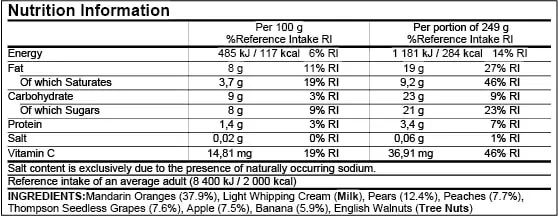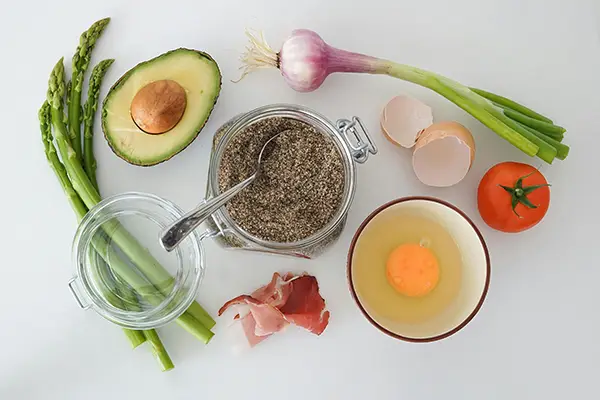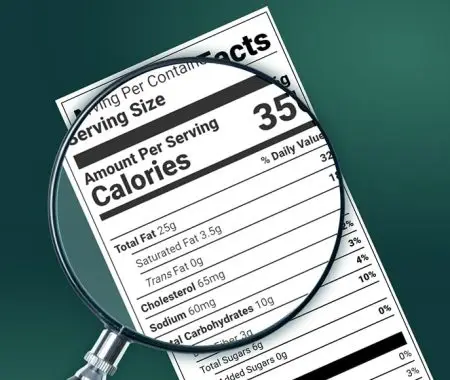“QUID” stands for a Quantitative Ingredient Declaration and is a way of declaring how much of a specific ingredient or group of ingredients is used in a product during the manufacturing or preparation process. It essentially indicates the percentage of each main ingredient in the food. The percentage information should be included right in the food’s name, next to the name, or in the ingredient list. Even for products that don’t normally need an ingredient list, the amount of certain ingredients still needs to be shown near the product’s name.
The QUID is crucial for compliance with EU food labeling regulations because it enhances transparency and consumer trust by precisely indicating the amount of significant ingredients in food products. This requirement ensures that consumers are clearly informed about the content of their purchases, particularly when the quantity of an ingredient is emphasized in the product’s marketing or is essential for defining the product. By mandating the disclosure of ingredient percentages, QUID helps consumers make more informed choices, supports fair competition among manufacturers, and aligns with the EU’s goal of providing high levels of consumer protection in food labeling.
TLDR
- EU Regulation (EU) No 1169/2011: This is the primary regulation overseeing the Quantitative Ingredient Declaration (QUID) in the EU. It mandates a clear indication of the percentage of key ingredients on food labels when their presence is emphasized either by the product name or through consumer association with the name, or depicted on the label.
- Purpose of QUID: The aim is to prevent misleading consumers about the quantity or proportion of an ingredient, enhancing their understanding of what they are buying. This regulation is integral to the broader EU legal framework that ensures consumers receive clear and comprehensive nutritional information.
- When QUID is Required:
- Name Inclusion: If an ingredient is part of the product’s name, e.g., “Beef Pie,” the label must state the percentage of beef.
- Consumer Association: If an ingredient is a significant focus for consumers, as with “Honey Oat Bread,” its percentage must be specified.
- Depiction on Labels: If an ingredient is highlighted through images or graphics, such as “Chocolate Chip Cookies,” the label must clearly declare the ingredient’s percentage.
- Examples and Format for QUID:
- Beef Pie: “Ingredients: Flour, Beef (40%), Butter, Water, Onions, Carrots, Peas, Beef Stock (10%), Salt, Pepper.”
- Honey Oat Bread: “Ingredients: Whole Wheat Flour, Water, Oats (20%), Honey (15%), Yeast, Salt.”
- Chocolate Chip Cookies: “Ingredients: Wheat Flour, Sugar, Chocolate Chips (25%), Butter, Eggs, Vanilla Extract, Baking Soda, Salt.”
- Calculating QUID Accurately:
- Determine which ingredients need a QUID declaration.
- Measure each QUID ingredient before processing.
- Adjust for any processing losses or gains.
- Calculate the final percentage using the formula: (weight of the ingredient/total weight of the product) × 100
- Address challenges like varying batch sizes or inconsistent ingredient quality to ensure accuracy.
- Compliance with QUID Requirements:
- QUID percentages should be clearly displayed either in the ingredient list or next to the ingredient’s name on the packaging.
- Regular checks and updates are necessary to ensure that the labels remain compliant with current regulations and accurately reflect the QUID percentages.
- Using tools and software provided by companies like Food Label Maker can ensure that you create compliant and user-friendly labels that promote accuracy and transparency when displaying nutrition information.
EU Regulations Governing QUID
The regulation known as (EU) No 1169/2011 is pivotal in governing the Quantitative Ingredient Declaration in the EU. This regulation enhances transparency by requiring food labels to clearly indicate the percentage of a key ingredient or ingredients when their presence is highlighted in the product name, or they are usually associated with the name by the consumer or emphasized on the label in any way.
The intent is to ensure that consumers are not misled about the quantity or the proportion of an ingredient in a product and so that they have a better understanding of what they are purchasing. This regulation is part of the broader EU legal framework that provides consumers with clear and comprehensive information on nutrition labels. The QUID must be presented clearly on the label, either in or next to the name of the food, or in the ingredient list.
See How FoodLabelMaker Can Help You
When is QUID Required?
QUID is required when:
- The ingredient in question is part of the product’s name
- Consumers primarily associate the product with a particular ingredient
- The ingredient is depicted on the label through words, images, or graphics
Examples of Products Requiring QUID and Formatting Declarations:
- For an ingredient in the product’s name
- If a pie is sold and marketed as a “Beef Pie,” the QUID must indicate the percentage of beef used in the pie. An example of the ingredient list with QUID percentages would be:
- Ingredients: Flour, Beef (40%), Butter, Water, Onions, Carrots, Peas, Beef Stock (10%), Salt, Pepper.
- For an ingredient associated with the product
- For “Honey Oat Bread”, oats and honey are what consumers primarily associate with the product. An example of the ingredient list with QUID percentages would be:
- Ingredients: Whole Wheat Flour, Water, Oats (20%), Honey (15%), Yeast, Salt.
- For an ingredient depicted in words, images or graphics
- “Chocolate Chip Cookies” have images of chocolate chips on the packaging or are mentioned in marketing text as containing “Chocolate Chips,” so the specific quantity of chocolate chips must be clearly declared. An example of the ingredient list with QUID percentages would be:
- Ingredients: Wheat Flour, Sugar, Chocolate Chips (25%), Butter, Eggs, Vanilla Extract, Baking Soda, Salt.
In each case, the percentage of the ingredient used is calculated by weight at the time of its use in the preparation of the food. This information must be clearly placed either in the ingredient list or alongside the product name where it is straightforward for consumers to find and understand.
How to Calculate QUID Accurately
Calculating the Quantitative Ingredient Declaration (QUID) accurately is essential for food manufacturers to ensure compliance with EU labeling regulations. Here’s a step-by-step guide on how to calculate the percentage of ingredients, taking into account factors like moisture lost or gained during processing:
- Identify Key Ingredients: Determine which ingredients need a QUID declaration, typically those emphasized on the label or expected by the consumer.
- Calculate Initial Quantities: Weigh out each QUID ingredient before processing. This will be your starting point for calculations.
- Adjust for Processing Losses/Gains: Adjust the weight of each ingredient to account for changes during processing. For example, if moisture is lost during baking or cooking, reduce the ingredient weight accordingly.
- Calculate the Final Percentage: The formula for QUID is the weight of the individual ingredient (x) divided by the total weight of the combined ingredients or finished product (y) and multiplied by 100 to get the percentage. This is the value that should be declared on the label.
(x/y) x 100 = QUID percentage
As an example, let’s say that you want to work out the QUID percentage you must declare for the chicken contained in a chicken pie. The individual weight of the chicken is 200 grams (x), and the total weight of the pie is 500 grams (y), the QUID percentage would be calculated as follows:
(200 grams of chicken / 500 grams total weight of pie) x 100 = 40%
So the QUID percentage for chicken = 40%
- Address Common Challenges: Common calculation challenges include varying batch sizes, inconsistent raw material quality, and changes in weight due to cooking or mixing. Ensuring accuracy might require averaging multiple batches or having more precise measurement techniques.
- Ensure Accuracy in Declarations: Regularly review and update calculations to ensure they reflect the current manufacturing process and ingredient quality. Consistency in ingredient proportions across all batches is crucial for accurate QUID declarations.
Complying with QUID Requirements:
Ensuring compliance with QUID requirements involves more than just accurate calculation but also the correct integration of this information on product labels. Here’s how to ensure that your labels are compliant and informative:
- Displaying QUID Information on Labels: Clearly show the percentage of QUID ingredients either in the ingredient list or next to the ingredient’s name on the front of the package. This should be in a readable font size and placed in an accessible spot for consumers to easily see.
- Regular Compliance Checks: Regularly review your product labels to ensure they meet all current regulations as being up-to-date with changes in legislation is essential for ongoing compliance.
- Training and Education: Train staff involved in recipe formulation and labeling on the importance of QUID and how to implement it correctly.
There are also tools and technologies that you can utilize to ensure compliance and accuracy without doing all the work yourself. Food label management systems offered by companies such as Food Label Maker can help you streamline your operations and create compliant labels. These platforms are well-versed in automatically calculating and updating QUID percentages based on your inputs. This not only reduces the risk of human error but allows you to scale with your growing food products and edit your labels to your business needs.
Common Pitfalls in QUID Declarations and How to Avoid Them
There are many errors that one can make when it comes to QUID declarations. These can include things like:
- Misjudging Ingredient Weight Post-Processing: Often, the error lies in calculating the ingredient quantities before rather than after processing which can lead to inaccurate declarations.
- Varying Legal Requirements: Specific legislation might dictate different points of measurement. For example, certain regulated products might require ingredient weights to be listed as they appear in their natural or raw state before processing.
- Using Processed Ingredients: When using ingredients that have already been processed before they are added to the mix (e.g., canned or marinated vegetables), the weight used for the QUID may need to consider the form in which they are added to the product, such as drained weight for canned goods.
- Inconsistent Batch Sizes: Fluctuations in ingredient proportions across different production batches can lead to discrepancies in QUID percentages.
To mitigate these errors, here are some practical tips you can follow to maintain compliance with EU regulations:
- Accurate Measurement: Always calculate the QUID based on the finished product to reflect actual ingredient quantities.
- Standardize Recipes: Maintain consistent ingredient proportions across all batches to ensure uniformity in QUID declarations.
- Staying Informed: Regular updates on regulatory changes are crucial. Utilizing resources like industry newsletters and regulatory advisories can keep you informed.
- Flexible Labeling Solutions: Implement label management systems that can easily update labels in response to ingredient or regulatory changes.

Conclusion
By following the relevant steps and using external tools or labeling software, manufacturers can enhance their compliance with QUID requirements. This is essential for QUID labeling as it ensures consumer trust and avoids any potential legal issues related to mislabeling. Accurate ingredient declarations can also help consumers make informed decisions about their food choices. There is also additional support and resources online in the form of Food Label Maker’s Regulatory Hub, the European Food Safety Authority (EFSA), or EUR-Lex.
FAQs
What is the quid in the quantitative declaration of ingredients?
The QUID stands for Quantitative Ingredient Declaration and it refers to a requirement on food labels where the quantity of certain ingredients that are used in a food’s production must be declared. It is expressed as a percentage and reflects the proportion of each ingredient at the time of its use relative to the finished product. This information must be clear and accessible to consumers so that they can understand what is contained in the food they purchase.



